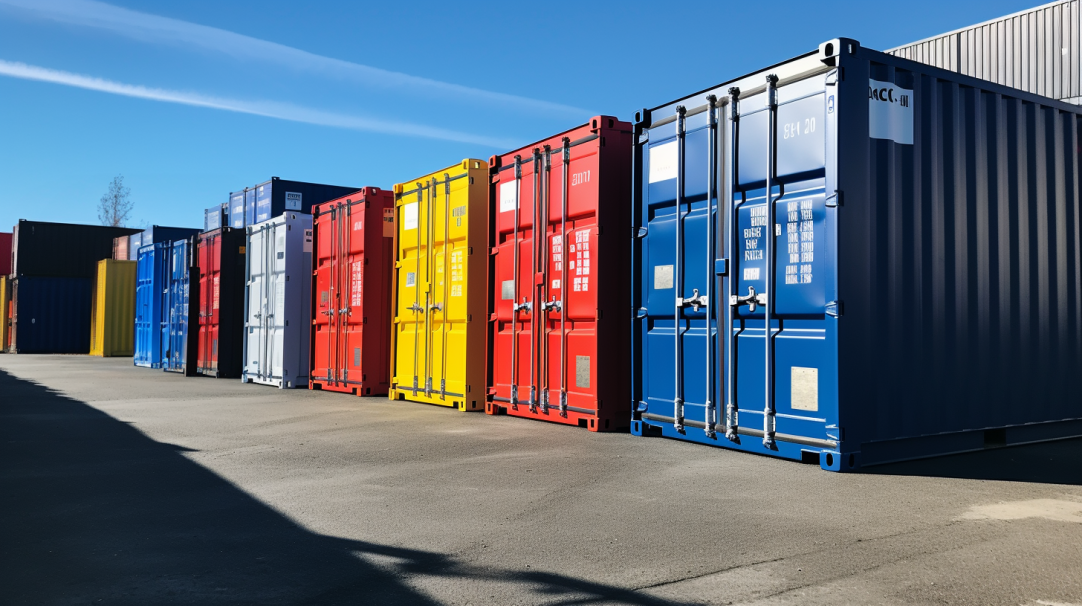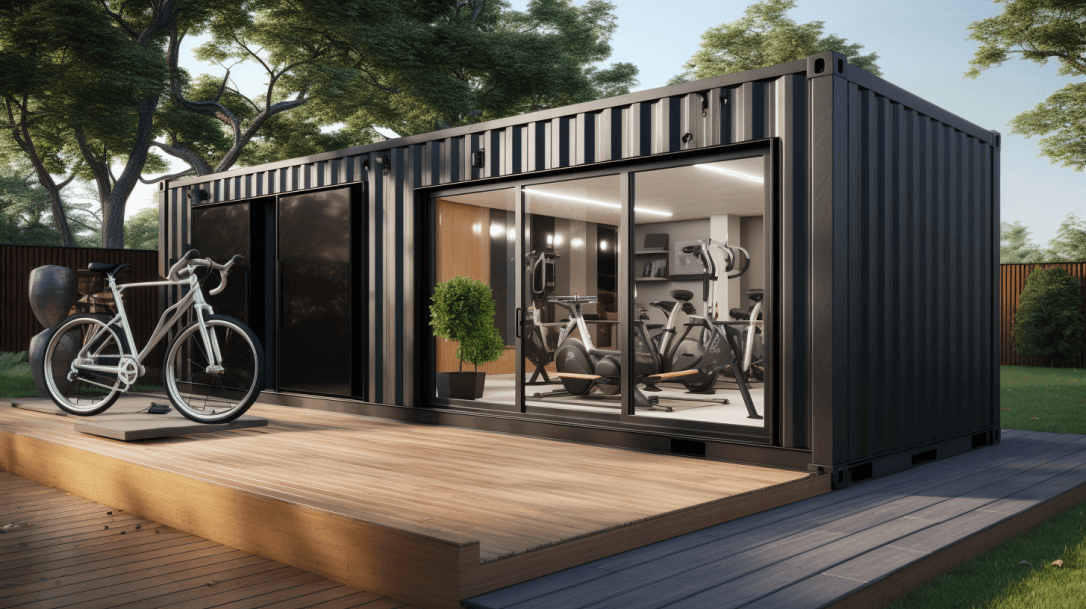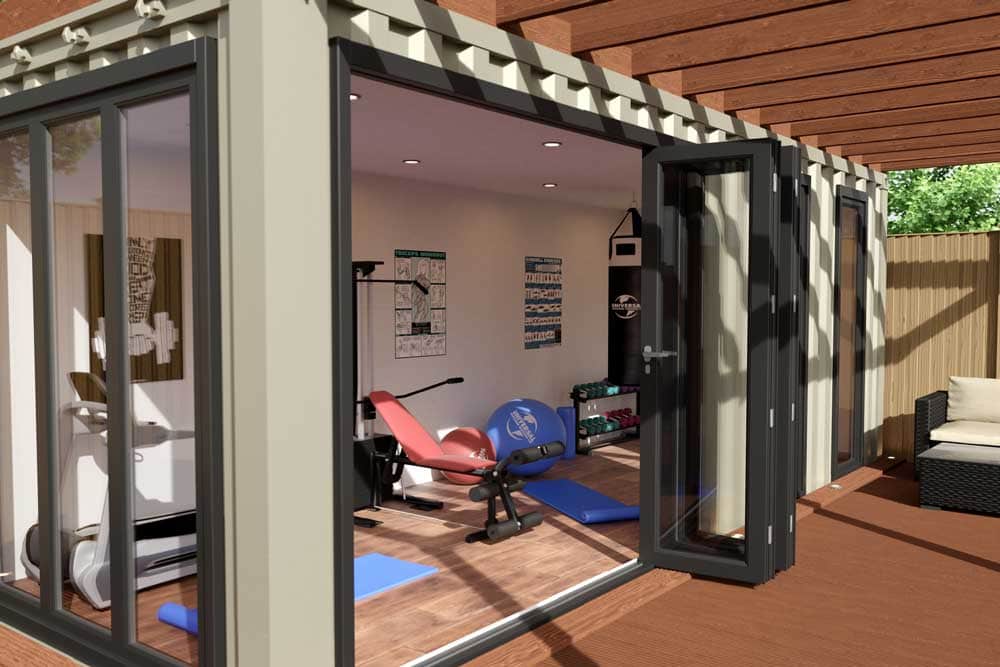Understanding the different container types is important. With so many options, choosing the right type of shipping container is not only crucial for the safety of your cargo, but also ensuring your shipment is cost-effective.
Standard shipping container types
There are several types of shipping containers, each designed for different cargo needs. Choosing the correct container is essential to avoid damage to your cargo and ensure smooth customs clearance at the destination, saving you time and potential costs.
The size of the shipping container is another crucial factor. For example, if you are shipping a large amount of cargo, a 40ft shipping container would be more economical than two 20ft ones.
Standard dry containers
Standard dry containers, available in steel or aluminium, are the most common in the industry. They most commonly come in 20ft and 40ft sizes, though you can also get custom sizes, like 10ft and 30ft. Standard dry shipping containers aren’t just used for transportation, they are also often converted into homes, offices, and commercial spaces.
High cube containers
High cube containers offer additional height, providing more storage value for your money. Available in 20ft HC, 40ft HC, and 45ft HC sizes, these containers are ideal for cargo that needs more space. They are popular and readily available, though prices can vary. You should be careful you aren’t paying more than you should.
Specialised shipping container types
Specialised shipping containers are made for items that can’t be sent or stored in regular containers. They have special features such as multiple cargo doors, open sides and tops, or specialised ventilation systems for cooling or storing hazardous materials .
It’s good to understand what’s available so you can pick the right container for your needs, transporting your cargo safely and efficiently.
Refrigerated containers



Refrigerated containers, or reefers, act like mobile fridges. This is perfect for cargo that needs to be kept at a certain temperature as they can maintain temperatures between -25°C and +25°C. Reefers are often used for items such as fruits, veggies, medicines, and meat. They have separate sections for cooling and freezing, powered by a generator. These containers come in 20ft and 40ft variations and their price can vary depending on any specific customisations needed.
Tunnel containers



Tunnel containers are also often referred to as open-sided or double door containers. They are designed with doors that open at both ends. This feature makes them ideal for loading and unloading oversized items. For example, if you’re loading a car, you can simply drive it straight through the container without the hassle of reversing to unload it. These containers are all about making the transport process easier and more efficient, especially for large or bulky items.
Open-top containers



Open-top containers are exactly what they sound like: containers with an open top. This design lets you cover them up with a specialised tarpaulin sheet or leave them open, depending on what you need.
They’re perfect for when your cargo is too big or awkwardly shaped to load in a standard container. Think of large machinery or heavy materials that can’t be loaded in from the side. Instead, you can easily load these items from the top using heavy-lifting cranes. This type of container is all about flexibility and convenience for oversized or challenging cargo.
Hard top containers
Hard top containers are similar to open-top ones, but with a detachable steel roof instead of a tarpaulin sheet. Just as with open top containers, these shipping containers are popular for cargo that is too cumbersome to be loaded through standard container doors. Heavy and tall goods can be loaded through the roof or doors with the help of equipment like forklifts, cranes, or crabs.
Pallet wide containers
Pallet wide containers are specially made to fit Euro pallets, which are (as the name suggests) commonly used in Europe.
They’re a bit different from your regular containers. For example, a standard 20ft dry container can fit 11 Euro pallets, but a 20 ft pallet wide container can hold up to 15 pallets. That’s because they’re designed to be about 5cm wider inside than standard units.
These containers are usually made of steel for strength, but the floor is lined with wooden planks. The wood not only makes the container more durable, but it also provides better grip, which is great for keeping things in place during transport.
Flat rack containers


Flat rack containers are unique because they only have sides at the short ends. They’re ideal for heavy and bulky cargo that needs to be loaded from the top or sides, like large machinery or oversized items.
These containers are built tough, with strong corner posts and reinforced frames to handle heavy loads and ensure stability during transport. They’re perfect for shipping specialised cargo that doesn’t fit in standard containers.
Side door containers



Side door access containers, also known as ‘open side’ containers, feature additional doors along their longer sides. This design is particularly useful for loading bulky items that can’t fit through the standard end doors.
The side doors provide full access to the container’s length, making it much easier and more efficient to load and unload large or awkwardly shaped cargo. Additionally, the extra space allows multiple workers to load or unload simultaneously, streamlining the process.
Insulated containers
Insulated shipping containers are designed to maintain a stable internal temperature by using vacuum-insulated walls that prevent heat transfer. They are suitable for items like cosmetics, chemicals, chocolates, electronics, and art pieces that require consistent temperature conditions during transport. However, unlike reefers, they do not offer precise temperature control.
Tank containers
Tank containers, often referred to as tankers or ISO tanks, are cylindrical units specifically designed for the transportation of dangerous goods, gases, and liquids.
Tank containers go through tough inspections. They must meet strict standards before use. Each tank is checked for size, durability, and strength. These checks follow ISO standards to make sure they are safe for transporting hazardous materials. The tanks need to be strong and secure for different transport conditions. They are reliable for shipping sensitive or dangerous liquids and gases.
COSHH chemical store containers


COSHH chemical store shipping containers are designed for safely storing and transporting hazardous substances, complying with COSHH regulations. They provide a secure environment for hazardous chemicals, reducing the risk of accidents or exposure and protecting people and the environment from dangerous materials.
COSHH containers have features such as: fire resistance, leak-proof design, and frost-free capability. If you are transporting and storing dangerous substances, this is likely the container you should use.
Half height containers
Half height containers are designed for heavy goods that don’t require the full vertical space of standard containers due to their shorter height. They are ideal for dense, heavy items like machinery parts or construction materials.
To ensure cargo safety, DNV-approved half height containers come equipped with features such as slings, shackles, and multiple internal lashing points for secure transportation. These containers can also be customised to meet specific needs, including adding removable sides or swinging doors for easier loading and unloading of heavy items. This customisation enhances container functionality and versatility for various heavy cargo requirements.
Other types of containers
In addition to the container types already discussed, there are several other specialised containers:
Cargo Storage Roll Containers: These are designed to keep goods organised and secure during transit. They are ideal for items that need to be readily accessible and protected throughout their journey.
Swap Bodies Containers: Specifically designed for multimodal transport, swap bodies are used for goods transported by both road and rail. They offer flexibility in intermodal transportation, making the transfer between trucks and trains seamless.
Car Carriers: As the name suggests, car carriers are tailored for shipping vehicles. They provide a secure and efficient way to transport cars over long distances.
Drums: Drum containers are used for shipping liquids and powders, typically in smaller quantities. They are essential for the safe and convenient transport of these types of materials.
Intermediate Bulk Shift Containers: Used for bulk shipping of liquids or powders, these are larger than drums so are used for transporting significant quantities.
Platform Containers: These are essentially flat platforms without side and end walls, making them an ideal solution for heavy loads and oversized cargo that cannot be accommodated in flat rack or open top containers.
How to choose the type of shipping container for your needs
Choosing the right type of shipping container for your needs involves several considerations:
Type of Cargo: As we have mentioned, the type of shipping container you need depends on your cargo. If you have general, non-perishable goods, standard containers might suffice. However, for perishable or temperature-sensitive items, refrigerated containers (reefers) are the way to go. Hazardous materials might require COSHH chemical store containers, and oversized items could need flat rack or open-top containers.
Capacity: Once you’ve decided on the container type, you need to decide the size. A 20ft container is suitable for a small amount of cargo, but if you have more items or bulky cargo, you might need a 40ft or larger container. The key is to ensure your cargo fits comfortably without paying for unused space.
Cost: Budget is a crucial factor. New containers are usually more expensive than used ones. Also, specialised containers like reefers or tank containers typically cost more than standard dry containers. Balancing your budget with your specific shipping requirements is essential for a cost-effective choice.
By taking into account these factors, you can make a more informed decision about which shipping container type is best suited for your cargo’s specific needs and requirements.
Conclusion
There is a shipping container suited to almost every cargo. Whether it’s standard dry containers for general goods, refrigerated containers for perishables, or specialised options like flat racks for oversized cargo, the industry has you covered.
Important considerations in selecting the right container include the nature of your cargo, its size, and your budget. This ensures you choose a container that is not only suitable for your goods but also cost-effective.
With our comprehensive range of new and used shipping containers, you’re able to find the ideal solution for your shipping requirements, guaranteeing safe, efficient, and economical transportation of your cargo.
FAQs
Which shipping container types are the most common?
The most common shipping container is the 20-foot, 40-foot, and 45-foot types.
- The 20-foot container, ideal for general cargo, measures 20 feet long, 8 feet wide, and 8 feet high.
- For larger shipments, the 40-foot container is suitable, with the same width and height but extending to 40 feet in length.
- The 45-foot container, offering more space, is 45 feet long, 9.5 feet wide, and 9.5 feet high, accommodating bigger loads.
What is the lifespan of a shipping container?
A shipping container usually has a lifespan of 8 to 12 years. After this, shipping companies often sell them because they become less efficient for international shipping, requiring more maintenance to meet standards.
Repairing these older containers can be challenging, so they’re typically replaced with new ones. The old containers are often bought by individuals or businesses who creatively repurpose them for various uses.
Why are shipping containers different colours?
The colour of a shipping container can help identify things like one-time use or cargo type. Colour can also affect the container’s price and use, as certain companies utilise container colours for branding purposes.





